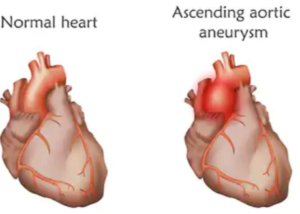
Here are guidelines for safely doing biceps curls if you have a thoracic aortic aneurysm: guidelines straight from an aortic repair surgeon.
If you’ve been diagnosed with a thoracic aortic aneurysm and have been lifting weights for years, enjoying a buff physique, does this now mean you’ll lose that physique?
Well, if you’re in training for a bodybuilding competition, you’ll have to give up your dreams. But that doesn’t mean you’ll regress to flab.
For this article my expert source is John A. Elefteriades, MD, a weightlifter himself, and William W.L. Glenn Professor of Surgery, and Director, Aortic Institute at Yale-New Haven, New Haven, CT.

Shutterstock/BLACKDAY
Biceps Curls and Thoracic Aortic Aneurysm: Is There Hope?
I was reading an online aneurysm forum in which an older man, an avid weightlifter for years, had recently learned he had a thoracic aortic aneurysm.
He posted a message stating that he’d have to work on accepting the fact that he’d never have the biggest biceps in the retirement living community.
Here is what Dr. Elefteriades says: “Exercises on relatively small muscle groups—e.g., curls—do not easily produce as much strain and blood pressure rise as those involving large muscle groups—bench press, lat pull-downs, squats.”
This is great news for that older guy with the thoracic aortic aneurysm who thinks his biceps will shrink from ceasing weightlifting.
If you’ve been diagnosed with a thoracic aortic aneurysm, you can still train fairly hard—with isolation routines.
If you do enough biceps curls (and triceps push-downs and kickbacks with cables), you can get a pretty good pump and good muscle fiber recruitment—enough to stimulate growth.
You won’t get a body like Mr. America with only isolation routines like biceps curls, but you can still get some nice, symmetrical muscles, especially since there are so many variations of biceps curls.
Not only are there a ton of biceps curl variations, but intensity techniques can be applied even if you have a thoracic aortic aneurysm, because the biceps are such a small muscle group.
If you have a thoracic aortic aneurysm, you can safely do 21s with biceps curls.
This automatically requires a non-heavy weight, since 21 reps need to be completed.
Another safe intensity technique is the drop-set. Though the “pain” is significant when you force yourself to muscle failure with biceps curl drop-sets, the strain on the aorta isn’t sufficient enough to set off alarm bells.
You can build a round, hard biceps also with curls using tension bands.
Feel free to do biceps curls with a barbell, dumbbells, kettlebells and cables, preacher machines, spider curls, concentration curls, the whole nine yards — even if you have an aortic aneurysm.

Freepik.com, senivpetro
However, if you must break form to get the weight up, use a lighter weight. Form should always be solid, and this can be your guideline for keeping the workout as safe as possible.
If you have a thoracic aortic aneurysm, you can get very nice arms from lots of biceps curls, triceps work and even isolation shoulder work like lateral lifts, front raises and reverse flyes.
Just make sure you always exhale during the lifting phase and inhale on the release.

Formerly the chief of cardiothoracic surgery at Yale University and Yale New-Haven Hospital, Dr. Elefteriades is working on identifying the genetic mutations responsible for thoracic aortic aneurysms. He is the author of over 400 scientific publications on a wide range of cardiac and thoracic topics.
 Lorra Garrick is a former personal trainer certified by the American Council on Exercise. At Bally Total Fitness she trained clients of all ages for fat loss, muscle building, fitness and improved health.
Lorra Garrick is a former personal trainer certified by the American Council on Exercise. At Bally Total Fitness she trained clients of all ages for fat loss, muscle building, fitness and improved health.
.


























